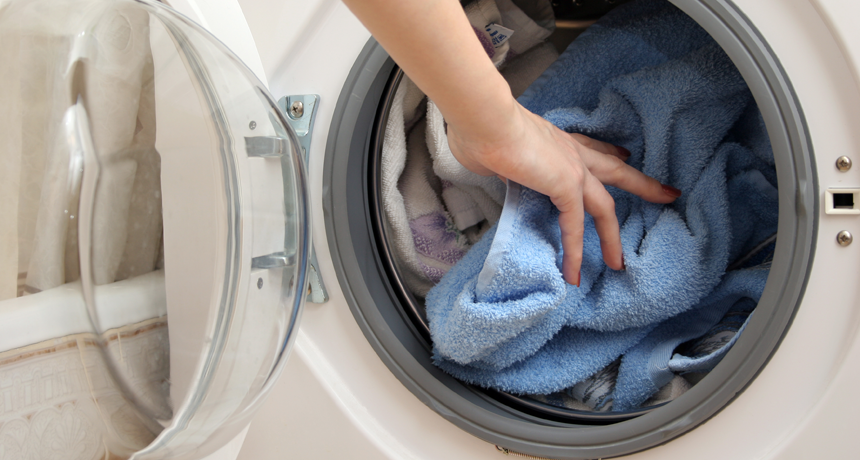Laundering clothes may send indoor pollutants outdoors
Clothing acts like sponges for pollutants — and doing laundry can ‘squeeze’ those pollutants back out of it again

Washing may release any indoor pollutants that clothes picked up. Some of the gaseous pollutants may go down the drain with the wash water — or get released outdoors via the dryer vent.
Denisenko / iStockphoto
Many items in homes, schools and businesses give off air pollutants, some of which may pose a risk to health. Those chemicals can be absorbed by clothing. And later, those pollutants can go down the drain with the wash water. Or they may even be sent into the air through a dryer’s vent. That’s the finding of a new study.
Flame retardants make products such as plastics and fabrics resistant to burning in a fire. Plasticizers are chemicals added to vinyl and certain other plastics to make them soft or flexible. Both types of chemicals have lots of beneficial uses. But research suggests each may be toxic if released into the environment. And both can leach from products into the air.
“People had looked at these chemicals in dust,” notes Miriam Diamond. She is an environmental scientist at the University of Toronto in Canada. But no one had looked at clothing as a possible environmental sponge for these compounds. So Diamond designed a study to learn if clothing might collect flame retardants and plasticizers from indoor air.
It made sense to her that they might. After all, she points out, even after walking away from a stovetop where you cooked an onion, “you smell of onions.” That’s because your clothes had absorbed some of the chemicals spewed into the air by the cooking veggies. Knowing that clothes can pick up kitchen chemicals, she was curious what other compounds fabric might collect from the air.
So she and her colleagues ran some tests — and were surprised by what they found.
What they learned
The researchers left two types of fabric in an office at the university for 30 days. One was made of cotton. The other was made of polyester. After the month was up, they measured the chemicals in these fabrics. Then they laundered the fabric and measured again. The researchers compared these results to chemicals they measured in the same type fabric that had not been exposed to the office air.

The fabric had been hung in special frames in the office. But nothing else was changed there. The researchers wanted to know what might be found in ordinary indoor air, Diamond explains. Many everyday items contain flame retardants and plasticizers. So the researchers looked for them.
Fabrics can be made from a complex mix of chemicals. What that mix consists of determines which air pollutants the fabric will catch and hold onto, Diamond says. In the new tests, each fabric picked up both flame retardants and plasticizers. But cotton fibers appeared better than polyester’s at collecting pollutants.
Cotton absorbed almost twice as much of some flame retardants as did the polyester. And the cotton absorbed as least five times as much of some plasticizers as did the polyester.
Both fabrics lost a good deal of the chemicals during washing and drying. But how much washed out depended on the pollutant.
Certain flame retardants came out of fabric faster than others. This included those made with chlorine and phosphate. An older type clung to cotton and polyester even through the wash. These are brominated flame retardants. But both fabrics shed far more of a type of flame retardants known as organophosphate esters (Or-GAN-oh-FOS-fayt ES-terz). This type “just floated away in the laundry,” says Diamond. The finding helps explain why these chemicals are now showing up in the wastewaters that enter a town’s water-treatment plants.
The new findings appeared August 10 in Environmental Science & Technology.
Probing that ‘sponge’ effect
These data “certainly demonstrate that clothing could be absorbing these chemicals over time,” says Heather Stapleton. She works at Duke University in Durham, N.C. She is an environmental chemist. And she has conducted many studies on flame retardants and their effects in the environment.
“Most of our research has focused on where these chemicals are being used in the home,” Stapleton says. These new data provide valuable clues about how those chemicals may be moving from the home and out into the environment. The new testing also “has provided some good insight into exposure pathways,” she adds. By that she means it points to where and how people may be exposed to these chemicals.
Indeed, the new data raise questions about how these fabrics might affect people, says Diamond. That’s because our skin makes contact with those spongelike fabrics that are soaking up pollutants.
Next, Diamond and her team will be working to pinpoint the indoor sources of the chemicals that collected in the fabrics she tested.
But there’s also another question Stapleton would like to see studied: How might the fabrics’ spongelike accumulation of pollutants affect the ability of these chemicals to enter the body. Clearly, she says, “There’s still a lot we need to know.”







